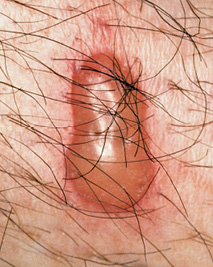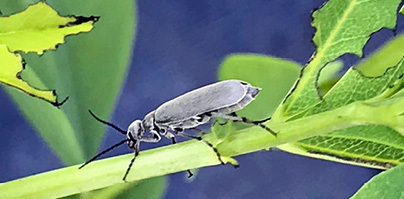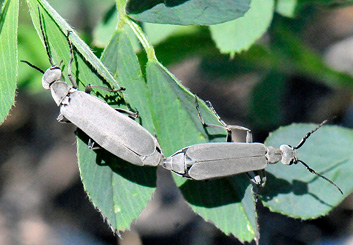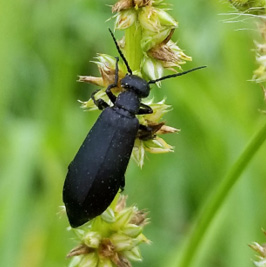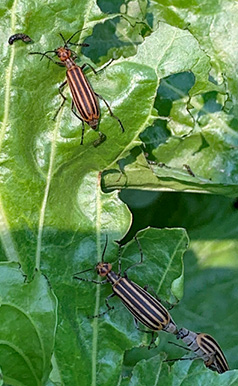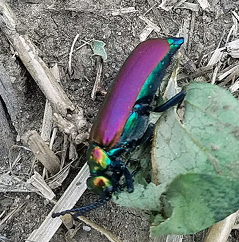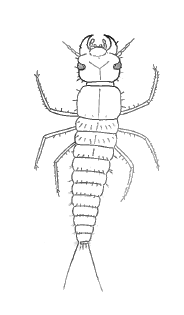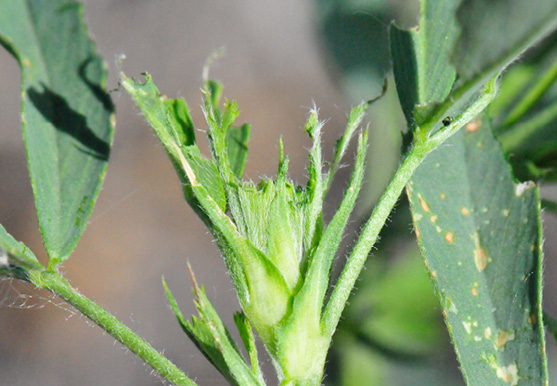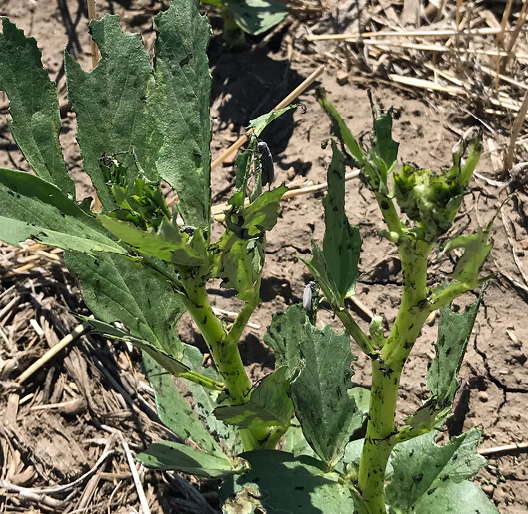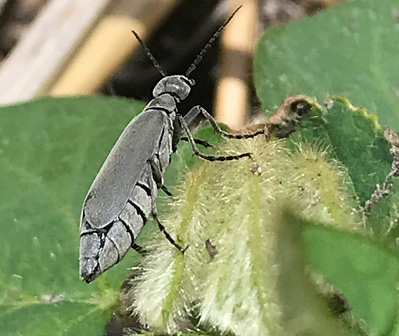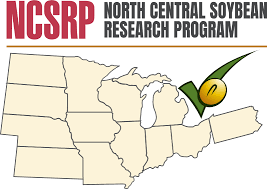Canola
Adult feeding on foliage is typically not significant enough to warrant an insecticide treatment. The “High Plains Integrated Pest Management Guide” recommends treatment when there are 10 adult blister beetles per plant feeding on the flowers or pods. Spot treatment with a foliar insecticide registered in canola usually is recommended.
Other Field Crops
Blister beetles usually are not economic insect pests of field crops, so there is no established threshold in most field crops. Blister beetles damage crops by eating the foliage, so the established defoliation threshold for other insects in beans [dry edible beans, faba beans and soybeans is suggested for blister beetle control. Control in bean crops is warranted when 30% of the foliage is destroyed prior to bloom or when 20% of the foliage is destroyed after bloom, pod set or fill.
Ash-gray blister beetles on soybean
Forage Crops
Alfalfa is a preferred host of blister beetles. Several management options are available, which can reduce the number of blister beetles found in forage crops, but none will eliminate the problem. There is no treatment threshold for blister beetles in alfalfa hay.
Adjust harvest dates and maintain weed-free alfalfa. Since blister beetles are readily attracted to flowering plants, controlling the number of flowering weeds in the field and cutting alfalfa prior to bloom stage (10% bloom) will reduce the potential for infestation. Blister beetles often feed for a short period of time and then disperse to other areas of the field or to new fields. After the alfalfa is cut, they often move out into blooming field crops nearby. Hay fields adjacent to rangeland pastures are often at higher risk for infestations of Epicauta species of blister beetles, since their host, grasshopper egg pods, are common in rangeland pastures.
Immediately prior to harvest, fields should be thoroughly scouted for new swarms of blister beetles, and if blister beetles are present in the field, the harvest should be delayed for several days. If large populations of blister beetles are observed, producers should not harvest until beetles have moved out of field or an insecticide could be applied. In many instances, the beetles will move. However, they may disperse to another part of the field, so careful and frequent scouting is necessary throughout the field. If beetles are present in the field at the time of harvest, avoid using mowers with hay conditioners or crimpers that may crush and kill blister beetles in hay and prevent them from moving out of the hay as it dries. Sicklebar mowers are no longer recommended for reducing blister beetles in baled forage. Research found that using sicklebar mowers increased blister beetles in the harvested hay because blister beetles were crushed when driving over the cut hay and then raked into windrows and baled. These implements increase the numbers of blister beetles located in hay and underneath the windrow. Even tractor tires can crush blister beetles in hay when turning equipment around. A self-propelled harvester which has wide-set wheels and no conditioner or crimping equipment is the best implement to use to cut and windrow the hay, resulting in fewer dead blister beetles in the hay. If large numbers of blister beetles are observed in spots during harvesting, stop tractor and go around blister beetles or allow them to move out of the way.
Scout harvested hay and underneath windrows closely for blister beetles and allow blister beetles to move out of drying hay before baling. Turning the windrow may be helpful to get blister beetles to move out. Although raking may dislodge some dead beetles from hay, it does not get rid of the problem of the cantharidin toxin in the hay if they are crushed.
Insecticides are not the best option for blister beetle management because dead beetles can still end up in hay and pose a serious toxicity risk to livestock. If high densities of blister beetles are present, an insecticide may be applied for control. Most beetles killed by the insecticide will most likely fall to the ground and should not be picked up by the harvesting equipment. However, dead beetles could be incorporated into cured hay, so it is important to not feed any contaminated hay to livestock. Remember, dead blister beetles still have a toxic level of cantharidin.
In all cases, contaminated hay should not be fed to horses or other livestock, and removal of the beetles from the hay will not make it safe. Cantharidin is a stable compound, and toxic levels will not be reduced during storage. Grinding hay only dilutes the toxin when the hay is mixed into a final ration with other non-toxic feedstuffs. Cantharidin concentration for blister beetle toxin in equine or ruminants can be measured by the NDSU Veterinary Diagnostic Lab: www.vdl.ndsu.edu/tests/blister-beetle-toxin-cantharidin/
It is to farmers’ advantage to minimize harvest operations which kill blister beetles, thereby minimizing the possibility of feed contamination. Pest management practices can only reduce the number of blister beetles present and the potential risk of cantharidin poisoning.
